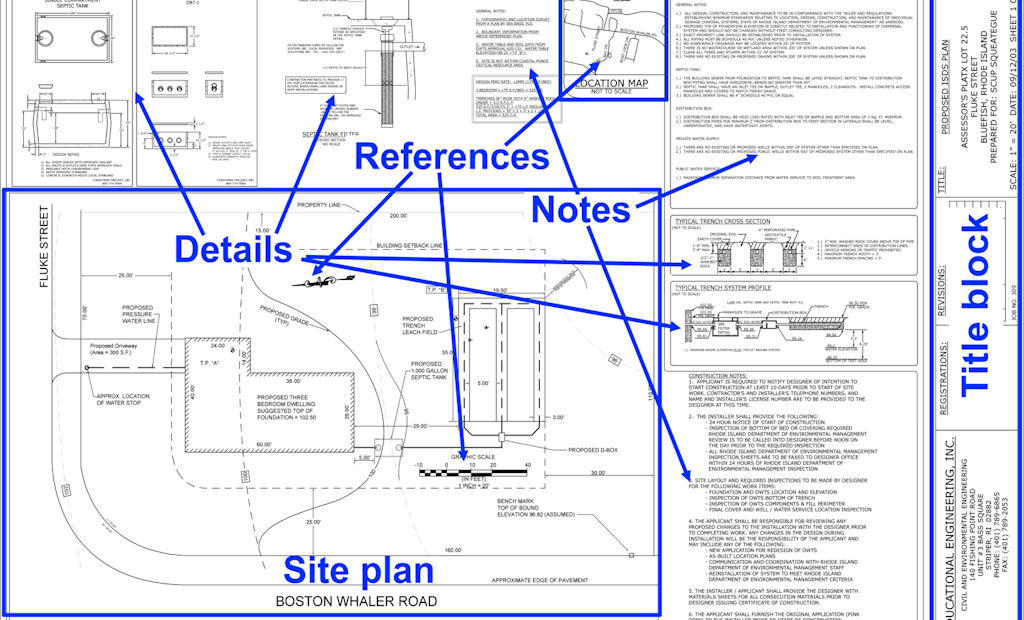Interested in Systems/ATUs?
Get Systems/ATUs articles, news and videos right in your inbox! Sign up now.
Systems/ATUs + Get AlertsAs preliminary and field information is collected, it must then be recorded and analyzed during the design process. If complete, no additional site visits should be needed unless final staking of the site is required. It is critical that the exact location of the proposed system site and soil information be identified. It is essential to relate the property location to field-identifiable reference points and to be very specific about test hole locations relative to both fixed reference points and each test site. One possible approach is to identify the distances between each test site and two reference points, such as a well and the corner of a building.
Preferably, all horizontal distances should be perpendicular to, and referenced to, a north-south line and an east-west line through the horizontal reference point, other fixed reference points, or identifiable baselines such as lot lines, roads, or fence lines. It is the designer’s responsibility to clearly identify the location of test holes by both vertical and horizontal references. The elevation of the ground surface at a test site and the reported depth of test are used to compute the elevation of the bottom of the distribution media when the system is constructed or when surface soil is removed. Quick and easy ways to measure elevations are with a builder’s level, a surveying transit, or a quality hand level.
Items to include in the design submittal are:
- Site visit date(s).
- Design of each component including relevant design calculations and sizing of each component.
- For sites with greater risk/regulatory controls additional items that may be included are:
- Groundwater mound evaluation — This can occur beneath soil treatment areas when the soil loading rates are greater than the soil’s hydraulic acceptance rate. An evaluation can determine the potential for excess water to build up. It may be required with larger flows from commercial or cluster systems and in areas with high water tables and likely lateral movement of water. This evaluation may affect the design of the soil treatment area to mitigate impacts.
- Nutrient impacts — Due to the size of the system or the sensitivity of the site, an evaluation of potential impacts of nitrogen and phosphorus may be required. Nitrogen evaluations may consider the impact to drinking water wells or coastal bodies of water. Phosphorus is most likely a concern near surface bodies of freshwater. It is common to have requirements that are more stringent on levels with coarser textured soils close to these surface waters. For environments sensitive to phosphorus or nitrogen, the design of the system will need to consider these items and possibly increase setbacks or add additional treatment steps.
- A map drawn to scale or dimension with a north arrow that includes:
- Horizontal and vertical reference points of the proposed soil treatment and dispersal areas, soil observations, and hydraulic tests (if performed).
- Distance from the system to all required setbacks, structures, easements, bodies of water, wells and property lines.
- Direction and percent slope.
- Depth of limiting condition (seasonally saturated soil layer or bedrock).
- Elevation of the bottom of the soil treatment system.
About the author: Sara Heger, Ph.D., is an engineer, researcher and instructor in the Onsite Sewage Treatment Program in the Water Resources Center at the University of Minnesota. She presents at many local and national training events regarding the design, installation, and management of septic systems and related research. Heger is education chair of the Minnesota Onsite Wastewater Association and the National Onsite Wastewater Recycling Association, and she serves on the NSF International Committee on Wastewater Treatment Systems. Ask Heger questions about septic system maintenance and operation by sending an email to kim.peterson@colepublishing.com.






